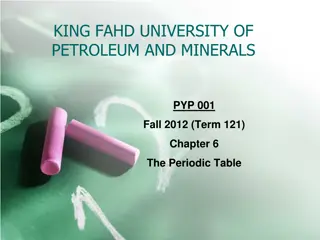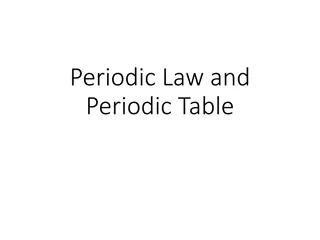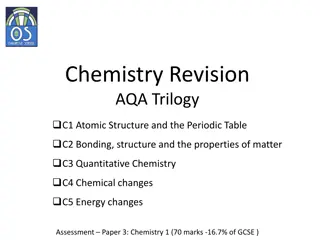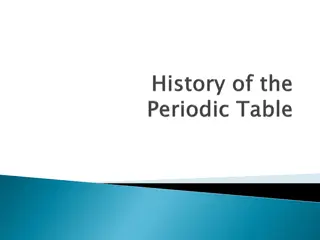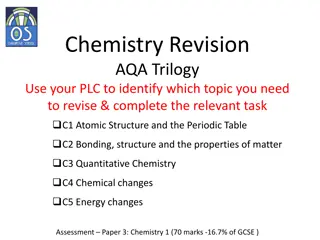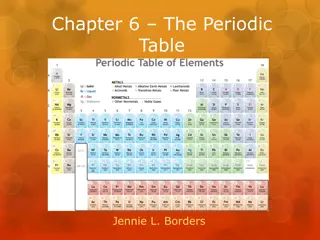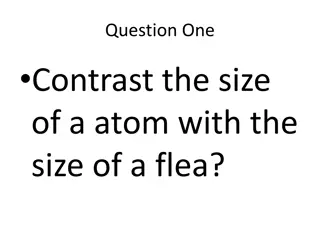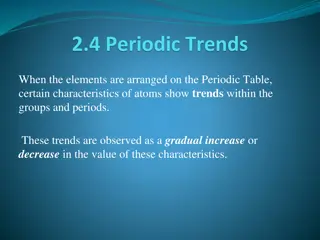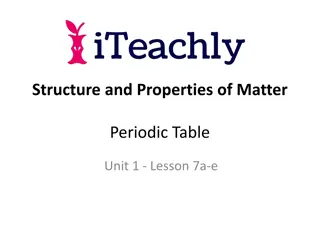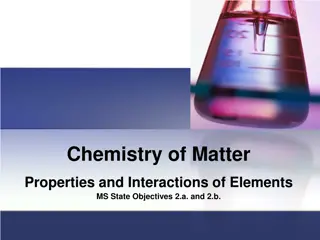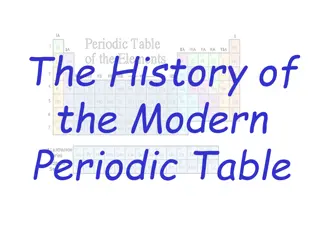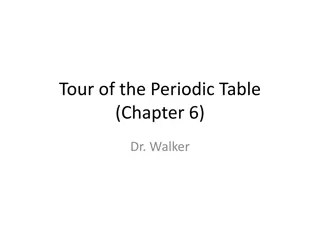Understanding the Periodic Table: Atomic Structure and Element Classification
Explore the fundamental concepts of the periodic table, including how to locate atomic numbers and masses, identify element groups, understand group and period distinctions, and analyze element properties. Delve into historical perspectives from scientists like D. Bereiner and Mendeleev, and grasp the significance of organizing information and patterns in science. Learn about matter, atoms, elements, and the evolution of periodic table models.
Download Presentation

Please find below an Image/Link to download the presentation.
The content on the website is provided AS IS for your information and personal use only. It may not be sold, licensed, or shared on other websites without obtaining consent from the author. Download presentation by click this link. If you encounter any issues during the download, it is possible that the publisher has removed the file from their server.
E N D
Presentation Transcript
At the end of this unit you should: 1. Be able to use the periodic table to find the atomic number and atomic mass of any element. 2. Know the different groups of elements in the periodic table. 3. Know why elements are in groups and periods. 4. Know how to investigate/explain the differences between different groups of elements.
alkali metals mass number atom matter atomic number noble gases electron octave element period groups properties halogens proton Law of Octaves shell Law of Triads valency
LIGHTBULB QUESTION Tables of information organise data in a way that allows you to: see a lot of information at once compare and contrast information using different headings alphabetise information or format in ascending or descending order summarise information by comparing it under different headings organise information so it can be used in charts or graphs see patterns in the information. At junior cycle level, science tabulating information is considered a form of analysis.
Matter: Anything that takes up space and has mass. Atom: The smallest particle of an element that has the properties of that element.
(a) What was scientifically useful about Dbereiners ideas? D bereiner was the first scientist to suggest that elements should be grouped by their similarities a basic idea that nearly all periodic tables have since followed.
(b) Why was Mendeleevs periodic table better than Newlands? Newlands pointed out that element properties seemed to repeat every eighth element, which was a good idea, but he linked this idea to a musical octave and forced elements to fit his pattern, which left him open to much criticism. Mendeleev improved on this by laying out his table using a repeating pattern and leaving gaps for undiscovered elements. He also placed elements according to their similarities and not always in strict ascending order of mass. Gallium, scandium and germanium were three elements whose discovery was assisted by Mendeleev s gaps, which predicted their properties. Their discovery proved that Mendeleev s approach was the correct one.
Group: A column of elements in the periodic table that have similar properties. Period: A row of elements in the periodic table that have the same number of shells.
LIGHTBULB QUESTION It is easier because it takes less energy to lose one electron than to gain seven. This means that losing electrons can be an easier way to get a full outer shell than trying to attract electrons. The less energy needed to hold the electrons in place, the more stable an atom will be.
(a) Draw the same type of diagram as Fig. 07.02.06 for both lithium and beryllium.
(b) If all the elements in a group react in the same way, can you predict how Group 1 elements react compared to Group 2 elements? Because they need only to lose one electron they are more reactive, as having one electron in the outer shell is less stable than having two electrons.
DEMONSTRATION Demonstration 07.02.01 Comparing Group 1 elements Equipment: Water trough, scalpel, clock glass, forceps, three wooden splints, cigarette lighter, safety screen, samples of lithium, sodium and potassium. Instructions: 1. Half-fill a water trough with tap water, and place behind a safety screen. You should be 1.5 m from the screen, and the room needs to be well ventilated. 2. Using a forceps, remove a cylindrical pellet of lithium from its container. Note that it is stored under oil. 3. Place the pellet onto a clock glass, and using the scalpel cut a sliver no thicker than approx. 3 mm from the pellet. See how the colour of the freshly cut metal dulls as it oxidises. The forceps may be needed to prevent the pellet from sliding off the clock glass due to the oil.
4. Return the pellet to the lithium container and secure the lid before proceeding further. 5. Light a splint. 6. Drop the sample into the water down the inside of the water trough. 7. As the reaction becomes more vigorous, the sample should move across the trough. The liberated hydrogen gas can be lit with the lighted splint. The reaction will fizzle out or may finish with a very small pop sound. 8. Using clean tissue, clean any residue from the clock glass, forceps and scalpel.
9. Repeat these steps with sodium and potassium. 10. If the sample is big enough, the sodium may self-ignite as the oxidation reaction will be enough to ignite the liberated hydrogen gas. The reaction should finish in a small pop sound. Potassium has a vigorous reaction so tends to self- ignite regardless of sample size. Caution is needed as the reaction nearly always ends in a popping sound. If the sample is big enough, this can eject debris.
Was there any pattern to how the elements did or didnt react? Each metal is soft, shiny and oxidises quickly (becomes dull). All float on water and have a low density. All react vigorously with water producing a gas. The gas is flammable. Each successive metal is more reactive/vigorous.
Investigation 07.02.01: Comparing Group 2 elements Equipment: Test tube rack, two or four test tubes, calcium granules, magnesium strip, water, 1.0 M hydrochloric acid, top- pan balance, weight boats, scissors, spatula. Instructions: 1. Two clean, dry test-tubes are sent up in a test tube rack and filled with equal volumes of water, no more than one-third the depth of the test tube. 2. Equal masses of each metal are placed one in each test tube. 3. Observations after addition to the test tubes should be recorded. 4. Then repeat the investigation using 1.0 M hydrochloric acid. 5. Observations again should be recorded.
1. How much of each metal will you use? 2. How much water/dilute hydrochloric acid will you use? In answer to both questions, you should consider fair test procedures and how the way in which the investigation is carried out could affect its results. For example a small piece metal about the size of your small fingernail should be used. No more than 5-8ml of water/acid should be used
3. Was there any pattern to how the elements did or didnt react? Find out if all tested element acted the same way or did their reactivity increase/decrease. 4. How does this compare to the Group 1 elements? State any patterns of reactions that match between the two groups.
5. Could you test Group 1 elements with dilute hydrochloric acid? Justify your answer. Hydrochloric acid could be used to test Group 1 elements, but in a school lab this would be potentially dangerous. Also, as a general rule, acids are added to other substances because they are highly reactive with many substances, so adding the Group 1 elements to a water trough full of acid would be potentially dangerous. This is in addition to having a large volume of acid in a wide and open container.
(a) Which group does the element thallium belong to? How many electrons will it lose or gain to become stable? Thallium (Tl) is in Group 3 and will tend to lose three electrons to become stable.
(b) Which group does the element xenon belong to? How many electrons will it lose or gain to become stable? Xenon (Xe) is in Group 8/group 0/the Halogens and has a full outer shell so is already stable and doesn t tend to lose or gain electrons.
(c) If both were used as gases to fill balloons, which would be the safer gas and why? Xenon, as it is unreactive compared to thallium.
LIGHTBULB QUESTION Because they need to either lose or gain a small number of electrons, some groups are more reactive. The less elements need to lose or gain, the more stable they (and their groups) are.
Valency: The number of electrons an atom must lose, gain or share to form a stable outer shell and chemically combine with other atoms.
Argon is used by the computer industry in clean rooms as a fire extinguishing gas. Why would argon gas rather than liquid or powder extinguishers be suitable for this purpose? Argon is used to put out fires for the following reasons: It is a heavy gas so will sink over a fire, displacing oxygen and removing an important part of the fire triangle. It is unreactive, so will not react with the computer components causing damage separate to the fire, as liquid or powder extinguishers might do. The argon can be cleaned up by simply pumping clean air into the room; it does not create further mess.
Copy and Complete In this unit I learned that the rows in a periodic table are called periods and the columns are called groups. Elements that react in a similar way go into groups. Alkali metals have only one electron in their outer shell/orbit. Alkaline earth metals have two electrons in their outer shell. Noble Gases are very stable/unreactive because they have eight electrons in their outer shell. Atoms can lose or gain or share electrons to become stable.
1. Fig. 07.02.08 shows a blank periodic table, with five elements labelled A to E. (i) Name each of the elements A to E. A rubidium (Rb) B caesium (Cs) C nickel (Ni) D silicon (Si) E radon (Rn)
1. Fig. 07.02.08 shows a blank periodic table, with five elements labelled A to E. (ii) Which element has an atomic number of 29? Copper (Cu).
1. Fig. 07.02.08 shows a blank periodic table, with five elements labelled A to E. (iii) Which element has an atomic mass of 28? Silicon (Si).
1. Fig. 07.02.08 shows a blank periodic table, with five elements labelled A to E. (iv) Which group do elements A and B belong to? Group 1 Alkali Metals.
1. Fig. 07.02.08 shows a blank periodic table, with five elements labelled A to E. (v) Give one difference between element B and element E. B is solid and a metal in Group 1, E is a gas and a non-metal in Group 8/0.
1. Fig. 07.02.08 shows a blank periodic table, with five elements labelled A to E. (vi) Why is element E more common in Ireland than in other countries? Radon is found in limestone areas, and as Ireland has much limestone we have a higher amount of radon compared to other countries.
2. Dbereiners Triads were not completely correct, but how did he help scientists understand more about the elements? D bereiner showed that elements followed a pattern when grouped by similar reactions. Other scientists used this basic idea to develop the periodic table further.
3. Why should Group 1 metals be stored in oil? To prevent them from reacting with oxygen or water in the air.
4. If you know the atomic number of an element in the periodic table, do you also know the number of neutrons in any atom of that element? Explain. No, the atomic number tells you the number of protons in an atom. This number and the mass number can then be used to find out how many neutrons an atoms has.
5. If you know that an atom has eight electrons on the second energy level and two electrons on the third energy level, explain how you know that this atom must be from the element magnesium. There are several ways to answer this question: If the neutral atom contains two electrons in the first shell, eight electrons in the second shell and two electrons in the third shell, it has twelve electrons in total. This means that its atomic number is 12 also, so it can only be magnesium (Mg). If the neutral atom has two electrons in its outer shell, then it belongs to Group 2, and if it has three shells then it is in the third period down so must be magnesium (Mg).
6. Read the following statement and decide whether it is true or false, giving reasons for your answer: If an atom has a low valency, it is always very reactive. This is true. A low valency means that it takes a smaller amount of energy to lose or gain electrons; this means that the atom will be more reactive.
7. Neon is a gas used in electric lighting. Why is it suitable for this? Neon is very stable because it has a full outer shell, so passing electrical energy through it will not cause it to become unstable, unlike other elements.




